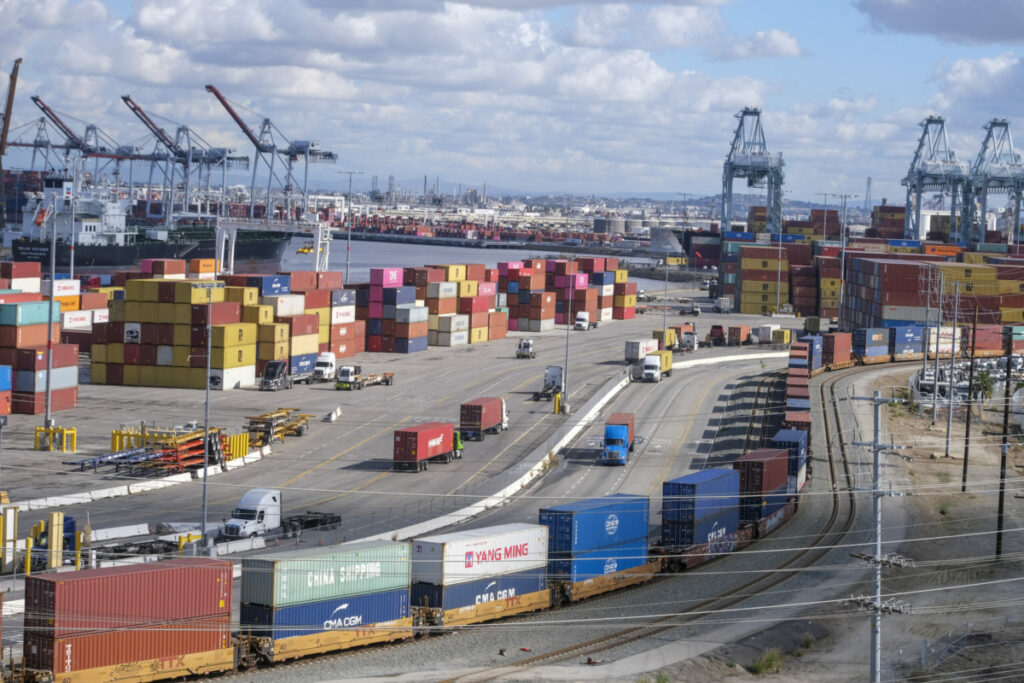Gone is that immense cargo ship logjam at the San Pedro Bay Port Complex that had been the odious illustration of the nation’s supply chain woes.
One reason for the cleared-up traffic, however, is not a great one: Ships from Asia in recent months increasingly have bypassed the ports of Los Angeles and Long Beach, partly to avoid the clogged ports and partly in fear of possible labor problems.
“Shippers are routing more cargo through the East and Gulf Coast,” said Gene Seroka, the executive director of the Port of Los Angeles. “That’s likely to continue until a West Coast labor contract is in place, and that can’t happen soon enough.”

Whether the cargo returns in the future is an open question, but for now port officials are pleased that the cargo clogs have been cleared.
“We’ve had a fantastic recovery from where we were in the summer of 2020,” said Mario Cordero, executive director of the Port of Long Beach. “In that context, I think I’d surmise that we’re having some normalization of container movement here.”
To be clear, cargo being processed at the ports remains near historic highs, even as they taper off from their peaks.
The Port of Los Angeles in September handled 709,873 twenty-foot equivalent units — the typical, if inexact, measurement of cargo container volume, based on the capacity of a 20-foot-long container and called TEUs — which represented a 21% decline from September last year. That includes 343,462 import TEUs (down 27% from September last year), 288,731 empty TEUs (down 20%) and 77,680 export TEUs (up 2.5%).
Through September, L.A.’s port has processed more than 7.86 million TEUs, a decline of 4% from the nearly 8.18 million TEUs from the same period last year. In total, the Port of L.A. moved 10.7 million TEUs in 2021.
“Despite the lower volume that we anticipate in quarter four, the Port of Los Angeles is still on pace toward its second highest volume year ever,” Seroka said in a media briefing about October’s numbers.
Meanwhile, the Port of Long Beach processed 741,823 TEUs in September, down 0.9% from 748,472 TEUs last September.
That being said, Cordero said the slight downturn lines up with expectations.
“This is no surprise. It was what was forecasted,” he said, adding that exports to the United States from China – the largest provider of West Coast cargo – were down 13% in October. “It’s a global scenario in terms of diminishment of growth. When you look at China…it’s no surprise.”
August was the Port of L.A.’s first cargo slowdown after 25 months of “record-breaking import volume,” Seroka noted, adding that the usual peak of holiday season goods came early this year, in June and July. great deal of holiday season goods have already arrived,” he said. “Traditionally, September was a high-volume month for end-of-year goods.”

Labor pains
Seroka added that, at the time of his briefing, there were 34 ships enroute to L.A., down from the typical mid-40s. One reason for this – that Asian shippers are routing cargo elsewhere in the United States – is at least partly related to a reason for the early peak: ongoing labor negotiations with the West Coast dockworkers.
The dockworkers’ contract expired July 1 and they have been working without one since. They earlier rejected a one-year extension. No strike has been announced. The port complex has a long history of strikes and labor strife causing significant delays.
Seroka said that the traffic slowdown likely to continue until a labor pact is in place.
Matt Schrap, executive director of the Harbor Trucking Association, said more shippers from Asia have been sending to ports such as New York-New Jersey; Charleston, South Carolina; Savannah, Georgia; and Houston. Even though those ports don’t necessarily have the same capacity that L.A. and Long Beach ports have, the shippers would rather avoid the possibility of striking workers inhibiting delivery.
“Shippers are going to be hesitant to put too much cargo into LA/Long Beach until that contract is finalized,” said Schrap, whose organization advocates for the interest of trucking companies and their drivers.
Greater efficiency also has played a role in bringing an end to the backlog.
After contending with the logjam of yore, cargo ships are essentially triaged as they arrive now, in order to avoid crowding the shoreline. Ships are brought in closer, essentially by tier, as they approach their scheduled offload time. That saves time.
There was a peak of 109 vessels within 150 nautical miles of the ports in January; during Seroka’s briefing, there were just six.
Shippers are routing more cargo through the East and Gulf Coast.
-GENE SEROKA
Port of Los Angeles
“By and large, inbound vessels are going to berth with little delay,” Seroka said.
As of Nov. 9, there were no ships waiting within 40 nautical miles of the port complex. Six ships were within 150 nautical miles and steaming toward the complex, with three apiece destined for the L.A. and Long Beach ports.
Cargo, after it is offloaded, is also getting out of the port more quickly, though there remains room for improvement there. Seroka noted that in October, there were about 41,000 import containers still in the Port of L.A.’s terminals, less than half the amount during the height of the import surge a year ago. Still, short warehouse space has caused delays in container pickup, with the average street dwell time being 10 days when it should be four, Seroka said
Quicker processing
Cordero, at Long Beach, hailed the port’s ability to process cargo that comes in. He had the numbers to back it up: on the year, its volume through three quarters – 7.34 million TEUs – is actually ahead of the 7.09 million from last year.
“We are very good at unloading vessels that come from Asia,” he said. “We do that around the clock. We’re very good at it.”
Schrap voiced support for the new queuing system, which he suspects will keep shippers coming here in the long term instead of committing to the other avenues.
“You’re talking 25, 35 ships at anchor waiting for a space in those (other) ports, whereas at LA/Long Beach we don’t have that problem,” Schrap said. “We’ll never see that amount of ships at anchor in part because of the queueing system but also because we’re seeing those decreased volumes in part as a result of the diversions and a slight softening of consumer spending.”
This relatively manageable time of cargo imports has presented opportunities to avoid the ship backlogs, or at least mitigate their severity, when the next crisis happens.
Part of that has to do with what happens to the containers once they’re ashore. In terms of the truckers, Schrap said they will have to adapt to when new standards next year will force trucks with engine model years 2007-09 out of service at the ports. There has already been a bull market for newer model trucks in anticipation of this, he said.
Enforcement of Assembly Bill 5, which severely limits who qualifies as an independent contractor, may also impede progress in efficiency.
“To an extent, would we like to see volumes return? Yes, but one thing that the supply chain crisis did was highlight a lot of the inefficiencies here locally,” Schrap said. “All that stuff really rose to the surface. Now, during this downswing, we’re working with our partners in trying to remedy some of those challenges that we saw when the spam hit the fan. There’s an opportunity now with those decreased volumes to help tackle some of those challenges that we experienced before and remedy them.”
Cordero said this breathing room right now could help everyone involved with cargo shipping.
“I think for us, what’s important at least at this point is to continue to work on lessons learned from the bottlenecks and congestion that we experienced as a result of the Covid-19 pandemic,” he said, adding that to maximize productivity, they have to maximize hours of operation at the ports.
